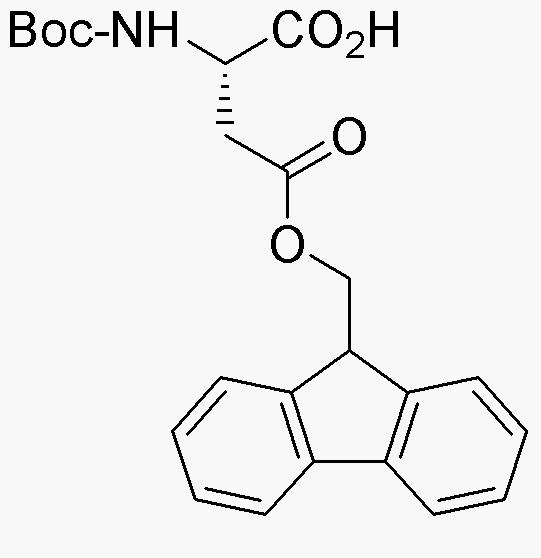Boc-L-aspartic acid b-9-fluorenylmethyl ester is widely utilized in research focused on:
- Peptide Synthesis: This compound serves as a key building block in the synthesis of peptides, particularly in solid-phase peptide synthesis, allowing for the creation of complex proteins with specific functionalities.
- Drug Development: Its derivatives are explored in pharmaceutical research for developing new drugs, especially those targeting neurological disorders, due to its structural similarity to neurotransmitters.
- Bioconjugation: The compound is used in bioconjugation techniques, facilitating the attachment of biomolecules to surfaces or other molecules, enhancing the efficacy of drug delivery systems.
- Research in Biochemistry: It plays a significant role in studying enzyme mechanisms and protein interactions, providing insights into metabolic pathways and cellular functions.
- Material Science: The compound is also investigated for its potential applications in creating novel materials, such as hydrogels, which can be used in tissue engineering and regenerative medicine.
Información general
Propiedades
Seguridad y normativas
Aplicaciones
Boc-L-aspartic acid b-9-fluorenylmethyl ester is widely utilized in research focused on:
- Peptide Synthesis: This compound serves as a key building block in the synthesis of peptides, particularly in solid-phase peptide synthesis, allowing for the creation of complex proteins with specific functionalities.
- Drug Development: Its derivatives are explored in pharmaceutical research for developing new drugs, especially those targeting neurological disorders, due to its structural similarity to neurotransmitters.
- Bioconjugation: The compound is used in bioconjugation techniques, facilitating the attachment of biomolecules to surfaces or other molecules, enhancing the efficacy of drug delivery systems.
- Research in Biochemistry: It plays a significant role in studying enzyme mechanisms and protein interactions, providing insights into metabolic pathways and cellular functions.
- Material Science: The compound is also investigated for its potential applications in creating novel materials, such as hydrogels, which can be used in tissue engineering and regenerative medicine.
Documentos
Hojas de datos de seguridad (HDS)
La SDS proporciona información de seguridad completa sobre la manipulación, el almacenamiento y la eliminación del producto.
Especificación del producto (PS)
La PS proporciona un desglose completo de las propiedades del producto, incluida la composición química, el estado físico, la pureza y los requisitos de almacenamiento. También detalla los rangos de calidad aceptables y las aplicaciones previstas del producto.
Certificados de análisis (COA)
Busque certificados de análisis (COA) ingresando el número de lote del producto. Los números de lote y de partida se pueden encontrar en la etiqueta de un producto después de las palabras "Lote" o "Lote".
Número de catálogo
Número de lote/lote
Certificados de origen (COO)
Este certificado de origen confirma el país en el que se fabricó el producto y también detalla los materiales y componentes utilizados en él y si se deriva de fuentes naturales, sintéticas u otras fuentes específicas. Este certificado puede ser necesario para cumplir con las normativas aduaneras, comerciales y regulatorias.
Número de catálogo
Número de lote/lote
Hojas de datos de seguridad (HDS)
La SDS proporciona información de seguridad completa sobre la manipulación, el almacenamiento y la eliminación del producto.
DownloadEspecificación del producto (PS)
La PS proporciona un desglose completo de las propiedades del producto, incluida la composición química, el estado físico, la pureza y los requisitos de almacenamiento. También detalla los rangos de calidad aceptables y las aplicaciones previstas del producto.
DownloadCertificados de análisis (COA)
Busque certificados de análisis (COA) ingresando el número de lote del producto. Los números de lote y de partida se pueden encontrar en la etiqueta de un producto después de las palabras "Lote" o "Lote".
Número de catálogo
Número de lote/lote
Certificados de origen (COO)
Este certificado de origen confirma el país en el que se fabricó el producto y también detalla los materiales y componentes utilizados en él y si se deriva de fuentes naturales, sintéticas u otras fuentes específicas. Este certificado puede ser necesario para cumplir con las normativas aduaneras, comerciales y regulatorias.


